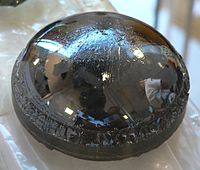
Photo from wikipedia
Abstract The role of hydroxyl-functionalization of reduced TiO2 (Blue TiO2) for the photocatalytic oxidation of toxic NOx was systematically explored in the present study. A hydrogenation technique was used to… Click to show full abstract
Abstract The role of hydroxyl-functionalization of reduced TiO2 (Blue TiO2) for the photocatalytic oxidation of toxic NOx was systematically explored in the present study. A hydrogenation technique was used to reduce the rutile phase in P25 TiO2 giving rise to a Magneli phase. Then, the process was followed by the surface functionalization of the Blue TiO2 with Trimethoxy (Propyl) Silane (TPS). The fabricated nanoparticles were structurally characterized, and photocatalytically tested for NOx abatement. OH-functionalized Blue TiO2 showed strong photo-oxidation of NOx with NOx removal efficiency of 80.2%. The broad-band light absorption (UV and visible) and the formation of a higher number of radicals on the surface of OH-functionalized Blue TiO2 made the material more efficient than other samples. In addition, the lowest NO2 selectivity of 2.7% proved the effective suppression of toxic NO2 and formation of nitrate ions. The reusability test was carried out for five cycles of 1 h and had 10% loss in NOx removal efficiency. The role of surface OH groups for the oxidation of NO and NO2 has been discussed in this manuscript. A possible mechanism for NOx photo-oxidation is proposed based on FTIR, ESR, and ion chromatography test.
Journal Title: Progress in Natural Science: Materials International
Year Published: 2021
Link to full text (if available)
Share on Social Media: Sign Up to like & get
recommendations!